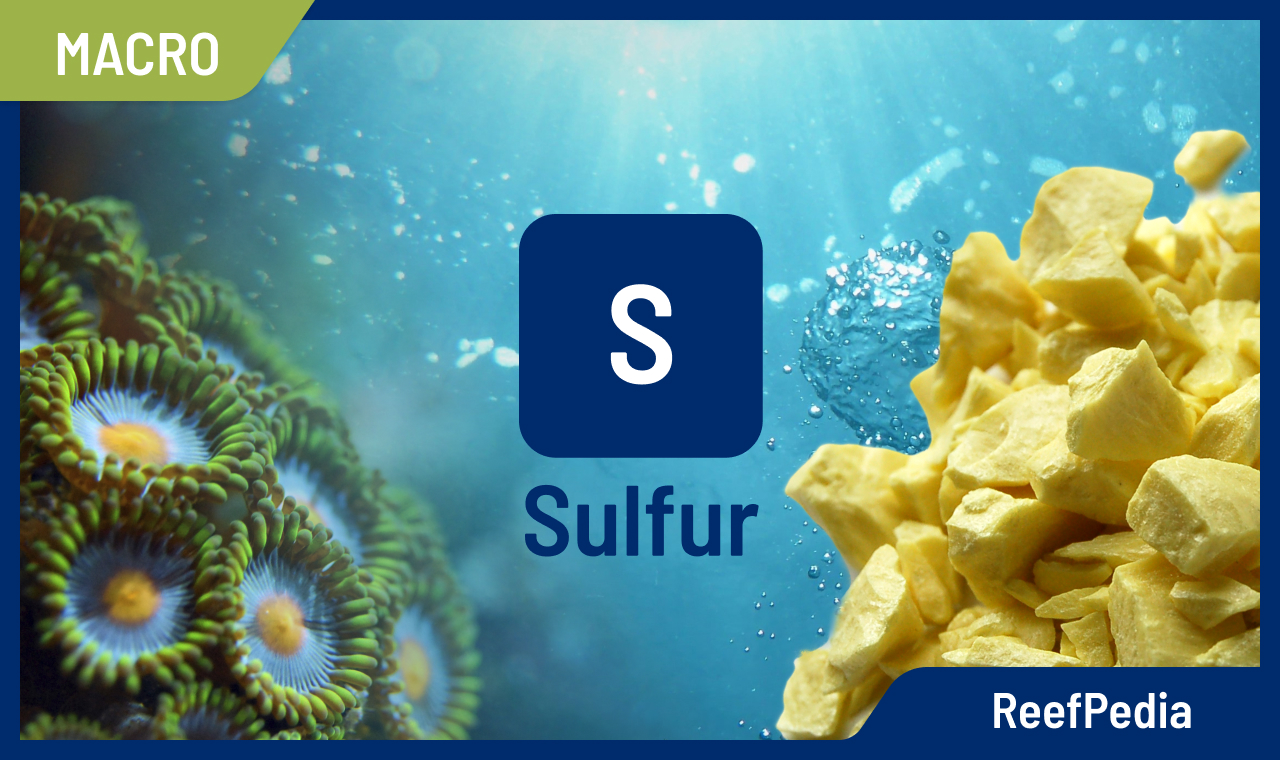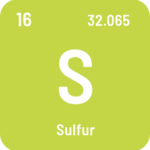 What is SULFUR (S)?
What is SULFUR (S)?
Sulfur (S, Latin sulphur) – a chemical element from the 16th group of the periodic table, the so-called aerobes*. Its content in the earth’s crust, both in the free and bound state, is about 0.048%. Sulfur deposits, where it is extracted in a free state, are located, among others, in Mexico, the United States, Russia, Poland and Japan. In the bound state, sulfur occurs in the form of metal ores, such as zinc blende ZnS, galena PbS, pyrite FeS2, chalcopyrite CuFeS2, and in the form of sulphates, such as gypsum CaSO4· 2H2O, anhydrite CaSO4, barite BaSO4.
Sulfur is essential for all living organisms. It is present in organosulphur compounds, such as amino acids (cysteine, methionine) and as a cofactor (chemical compounds that enzymes need to catalyze specific chemical reactions) in proteins, such as glutathione disulfide.
In seawater, sulfur is most commonly present in the form of water-soluble sodium (Na2SO4) and magnesium (MgSO4) sulphates. It belongs to the group of macroelements, and its optimal content is 850-950 ppm.
The importance of sulfur in sea water
Sulfur is one of the most common elements found in seawater. In the structure of corals, sulfur occurs in the form of organic phases (compounds containing carbon in their structure) and inorganic (compounds that don’t contain carbon in their structure, e.g. Na2SO4). Both forms are useful, compounds from the inorganic phase mainly build the coral skeleton, while coral-associated bacteria feed on organic sulfur compounds. Sulfur has several important functions in corals:

The roles of sulfur
Construction of the skeleton
The correct concentration of this element allows corals to grow healthy. The results of the studies on coral skeletons show that sulfur is involved in the process of skeleton formation. It penetrates mainly in the form of sulphates (SO42-) into the structure of aragonite and calcite. In addition, coral skeletons consist of i.a. Galaxin polysaccharide (a protein rich in cysteine, which contains sulfur in its structure).
Participation in the economy of oxygen
Sulfur is also present in seawater in the form of biogenic dimethyl sulfide (DMS) and its two main precursors, dimethylsulfoniopropionate (DMSP) and dimethylsulfoxide (DMSO). Biogenic elements are elements that are part of chemical compounds present in plant and animal organisms. The abovementioned compounds are an example of potential scavengers of reactive oxygen species in marine algae. In addition, dimethylated sulfur compounds may be involved in the antioxidant system of algae.
Zooxanthellae
Endosymbiotic corals and algae use sulfate ions in many ways, also indirectly. Zooxanthellae are needed for the proper development of corals, which in turn use sulfur compounds contained, among others, in amino acids.
Coloring of corals
The correct concentration of this element allows you to maintain intense coloration in corals.
Problems related to excess or deficiency of sulfur in seawater
Low concentrations of sulfur can worsen metabolic processes in marine animals. Its too low content can lead to RTN and STN diseases in SPS corals.
Sulphates (SO42-) intrinsically are not dangerous, but the reduced form of sulfur (S2-) is. The reduced forms of sulfur are most often found in the anaerobic zones of the aquarium, they are very toxic and often cause problems.
High sulfur concentrations can negatively affect the health of corals and other marine animals.
How to protect the aquarium?
The sulfur content should be checked regularly and kept at the correct level. We recommend keeping sulfur between 850 – 950 mg/L, and the optimal value we recommend is 900 mg/L. Such a level of sulfur in seawater ensures health and beautiful coloration of animals.
The most accurate and reliable method of sulfur determination in seawater is the ICP-OES analysis, i.e. Inductively Coupled Plasma Optical Emission Spectrometry.
Indicators of abnormal sulfur levels in a marine aquarium
Bacterial diseases on corals may indicate a sulfur deficiency, though there are no species of animals or algae sensitive to both overdoses and sulfur deficiencies.
Check out the indicators below that can help you know if the sulfur level in your tank is abnormal:
Deficiency:
- Pale colors
- Poor growth
- Bacterial infections
Excess:
- in anaerobic areas it can lead to the generation of hydrogen sulphide, which is toxic to organisms
Recommendations
To ensure the correct level of sulfur in the aquarium, you should systematically analyze the water and ensure the proper level of the element.
If the sulfur level is above 950 mg/l, we are talking about an overdose. The most common reasons for exceeding the recommended sulfur level are: too high doses of administered liquids (check the dosing parameters on the dosing pumps), improperly prepared salt, contaminated supplements or frozen and dry food.
Find and eliminate the cause of the problem by lowering the value of this parameter in the water. Do up to 6 water changes. It’ss recommended that at each water change approximately 15% of the aquarium water volume be replaced, until the recommended value of this parameter is reached. Water prepared for replacement must be characterized by an appropriate level of target salinity. Use salt with the correct parameters and composition.
If the sulfur level is below 850 mg/l, we recommend using products that contain this element to compensate for the sulfur level. To ensure a constant level of sulfur in a marine aquarium, we recommend systematic supplementation of this element – depending on the corals in the aquarium.
*The name aerobes comes from the name of the first element placed at the top of the sixteenth column of the periodic table (O-oxygen).
About author

Magdalena Metzler
Privately, I am a mother and a lover of nature and sport. My main interest is quantum chemistry, which hides a whole lot of unsolved mysteries and connections, which is extremely exciting from a scientific point of view.
In my scientific career, I have conducted international projects focused on innovative solutions for many branches of business, e.g. automotive, construction, and now, of course, marine aquaristics.
Working at Reef Factory gave me a passion for marine aquaristics, which I can develop every day, building a chemistry department and creating products that will help aquarists take care of tanks and ensure the highest safety of animals.
One of the most exciting memories of working at Reef Factory is the commissioning of the ICP-OES spectrometer, which analyzes the elemental composition of seawater. The method of analysis in ICP is based on an analytical technique, which is a combination of my passion for quantum chemistry and marine aquaristics.
I hope you find my articles on ReefPedia interesting and helpful! Happy reading :))
Magda


 What is SULFUR (S)?
What is SULFUR (S)?